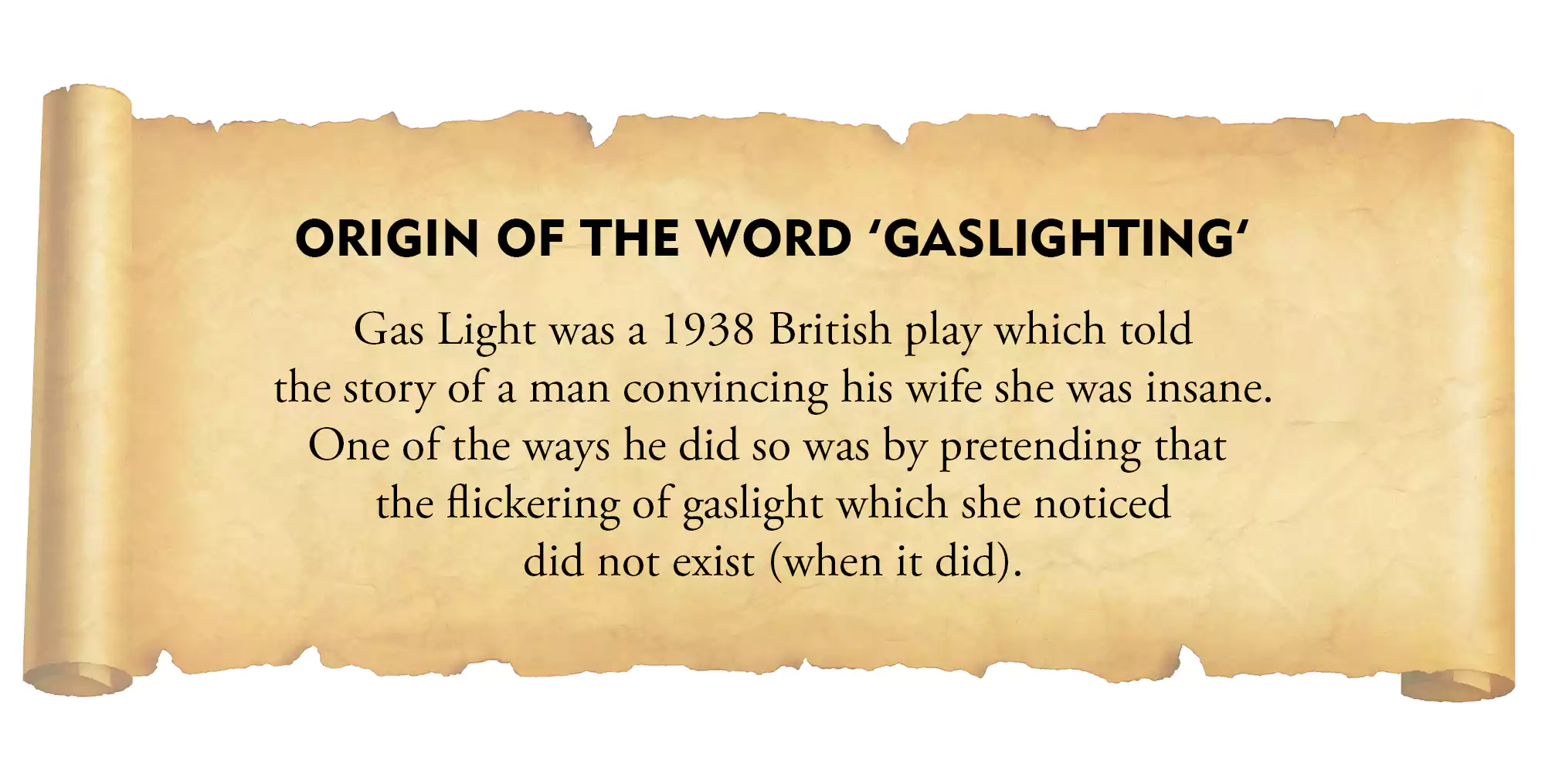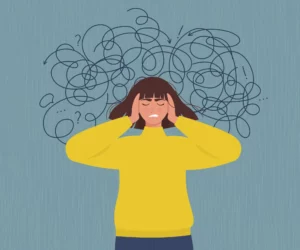
“OMG! Soooo toxic!” “There are so many red flags here; it’s like a rally in Soviet Russia!” “My ex was an expert gaslighter!”
These remarks abound on social media, especially when discussing interpersonal conflicts. You can see one of these words, ‘gaslighting’, in various contexts. So what is it? Are we using it accurately? Or is the meaning sometimes distorted in an unhelpful way to mental health conversations?
Specific terms are helpful because they give people a way to express what they are going through and describe uncomfortable or harmful behaviour. These terms, in turn, help them (and others) acknowledge what is happening and decide how to deal with it. But for these terms to be useful, they must be relevant and appropriately used. So let’s look at what appears to be the internet’s current most popular word: gaslighting.
Gaslighting behaviour
Gaslighting primarily occurs in two ways. For simplicity’s sake, let’s call them Dismissal and Creation.
Dismissal: X brings up Y’s behaviour or an incident involving them, and Y deliberately denies any such thing happened.
Creation: Y convinces X that they have forgotten something. Y creates a new memory or uses words they did NOT actually use earlier.
Thus, gaslighting is a conscious and manipulative act. It is a form of emotional and psychological abuse in which the abuser/bully misleads the victim into believing a false narrative and questioning their own selves. According to the Collins dictionary, someone is said to be gaslighted (or gaslit) when “[…] controlled by someone who makes them believe things about themselves that are not true.”
Unfortunately, the term, in its everyday usage today, has been reduced to a catch-all phrase. It is used for any situation where two people have differences of opinion. ‘I think you’re overreacting’, ‘I can’t do this right now’, and ‘Why do you keep doing this?’ are some common expressions associated with gaslighting. Identifying whether these expessions have a recurrent pattern and are used to sidestep any conversations about what is going on is essential. It is also important to consider how the person being dismissed or questioned feels.
Working with a professional can help with occasional, angry communication. Therapists could assist couples in identifying ways to communicate better so no one feels dismissed or trivialised. However, it is a clear red flag when one partner repeatedly uses responses that belittle the other, deflect from a topic, or dismiss another person’s concerns or feelings. If they cause the person to doubt themselves without allowing a proper, open conversation, it’s certainly time to talk about gaslighting!

When someone IS going through gaslighting
A gaslit person’s entire reality and thoughts come under scrutiny. One way of confirming incidents is to record interactions for posterity. But this is not feasible every day—nor the sign of a healthy relationship!
A gaslighting abuser may make the victim believe they ‘provoked’ the abuse. And when the victim defends themselves in some way, the gaslighter may use this defensive behaviour to paint the victim as abusive. They may also manipulate conversations to make it seem like the other person often forgets things and needs help remembering. Such manipulation can make the victim dependent on the other person to ‘keep track of things’. Ultimately, victims may hold themselves entirely responsible for any confusion, conflict, or even cruelty they experience.
Gaslighting may also lead to isolation as the person withdraws from social situations. This isolation may be at the abuser’s insistence. It helps avoid questions or suggestions from others that highlight discrepancies in their experience.
Even recognising that one is being gaslit may be a journey, as the person may not see the situation for what it really is. They may have become excessively dependent on the other person. In addition, they may even begin to wonder if they are ‘exaggerating’ when speaking to others. Moreover, they may doubt whether they can trust their thoughts or opinions about events.
A concerned outsider who recognises the abuse may be able to help by offering support and suggesting some actions to take. However, pushing them too hard is not advisable (as it may lead to further resistance). Instead, one can gently encourage the person to make time for themselves, doing things they enjoy. This can help a person feel good about themselves and experience a sense of pride and belief in their abilities. Doing things they enjoy also allows them some healthy space from the dependency in the relationship.
Even if a person leaves such a relationship, they may still be overly reliant on others to validate or verify their thoughts and feelings. As a result, they often need further help to undo the damage to their self-belief. Regaining confidence in their memories and experiences is key to healing. Again, a professional trained in working with abuse victims may be of great help.
Who gaslights? Who gets gaslit?
Mainstream culture often depicts gaslighting in romantic relationships (which is how the term arose!). But gaslighting can occur between any two parties—between friends, employers and employees, within families, etc. Moreover, even governments can gaslight citizens by pretending all is well during an evident crisis, simply denying the evidence presented to them.
Within the family, parents or elders may often gaslight children. This type of gaslighting is critical as several cultures endorse the idea of children being subject to their parents’ authority or that of any older family member. These cultures are even perpetuated and further distorted by entertainment media, which doesn’t help the case. Thus, a child may often be accused of something without a chance to defend themselves. Parents may also end up punishing the child (either physically or by withholding certain privileges) for perceived flaws and then convince the child that they “deserved it”.
There must be a line between appropriate parental authority and abuse. One way to prevent crossing this line is sharing interpretations, giving the child space to explain what they think happened, and apologising* when the adult is wrong. In addition, family therapy may be essential if the abovementioned behaviours often occur in interactions.
Gaslighting in popular media
Seeing gaslighting and psychological abuse in mainstream media can help people identify what is happening to them. According to a report released by Refuge, a UK-based organisation to help women and children escape domestic abuse, the number of helpline calls increased after TV shows depicted such abuse. Some TV shows now consult with these organisations, ensuring they portray abuse accurately in a way that could help victims. While using terms like gaslighting or abuse loosely on social media can be harmful, discussions around TV shows on these platforms are a great way to spread the message! Concerned friends or family can also casually share a link or initiate a discussion about a ‘TV show’ or ‘book’ to share information without directly forcing the victim to address their situation. Again, the intent needs to be clear; it is best to not involve yourself if you’re unsure of the situation.
Gaslighting is cruel and damaging. However, using the term loosely to refer to all instances of disagreement or conflict is unhelpful and unfair. As with any mental health term, using correct labels can greatly empower victims. Giving a name and shape to their distressing or traumatic experiences makes it easier for them to reach out for help.
*An apology re-establishes a sense of balance in the relationship. The child receives a voice and the dignity they deserve through the apology. The child also realises that apologising is a simple and natural thing to do. As a result, communication and trust between the child and parents can improve significantly. Other adults in the family should also watch for these instances to be objective third parties and effective advocates.



